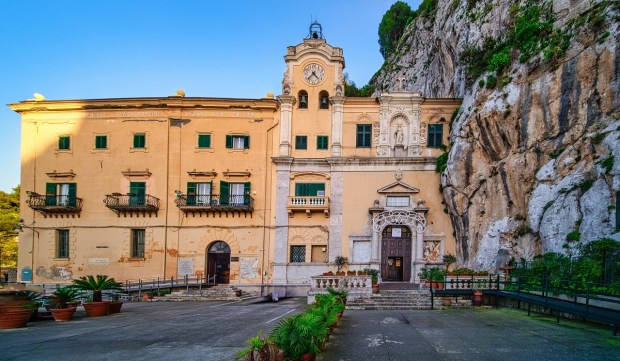It’s hard to visit Palermo without understanding the deep devotion that binds locals with their patron saint, St. Rosalia. The urban landscape of Palermo itself is dominated by the relationship between locals and the saint, with the Sanctuary of Santa Rosalia towering over the Sicilian city from its hilltop location on Mount Pellegrino.
According to a local tale, it was in a cave on this mountain just outside the city that on July 15, 1624, the relics of Rosalia – a local noblewoman who had retired to Mount Pellegrino to live her devotion as a hermit – were found inside a cave.
After the miraculous find, the relics were paraded through the city and the fast-spreading plague that had been tormenting locals for months ended. Since then, Palermitani adopted Santa Rosalia as their patron saint with a moving and heartfelt celebration taking place each year during the Feast of Saint Rosalia on July 15, culminating with a procession from Palermo up to Mount Pellegrino.

This year marks the 400th anniversary of the discovery of the miraculous remains of Santa Rosalia and Palermo will celebrate the “Santuzza” (“little saint” in Sicilian) with a rich calendar of events and cultural initiatives starting from May until early 2025.
Rosalia 400
One of the highlights of the celebrations is the monumental exhibition called “Rosalia 400” set up in Palazzo Branciforte, curated by Laura Barreca with the support of the European Union’s Cultural Heritage Active Innovation for Next-Gen Sustainable Society Program, which includes a guided walk inside the Monte dei Pegni, a large room lined with ceiling-high wooden shelves that used to host Palermo’s pawnshop where citizens could sell objects for cash. The pawnshop, locally known as “Monte Santa Rosalia,” has played a crucial role in the daily lives of people since its establishment in 1800.
The heart of “Rosalia 400” is a multi-disciplinary exhibition called “The Carriage, the Feast, and the Saint” curated by the Beaux Art Academy, focusing on the themes of rebirth, resilience, and devotion. Hosted inside former horse stables, it features drawings, photographs, and various visual materials documenting the celebration of Santa Rosalia over the years, including photographs from iconic Palermo photographer Letizia Battaglia.

“This year Palermo is going to celebrate a journey that began in 1624 and today is marking 400 years of history and traditions,” said the Mayor of the Municipality of Palermo, Roberto Lagalla, in a press release. “It is going to be a busy year of celebrations dedicated to Santa Rosalia which, thanks to the active participation of the entire territory and institutions, will allow the tourist revival of the city with a renewed metropolitan internationally oriented identity.”
Celebrations will likely draw many devotees from the US, where Catholics of Sicilian heritage maintain a special devotion to St. Rosalia with dedicated parades held each year in New York.
For the duration of the 400th anniversary celebrations, visitors will be able to explore the Sicilian capital with dedicated spiritual and cultural itineraries that explore the complex and rich history of this city built at the crossroads of the Mediterranean.
“Palermo will express itself in all its beauty, through spiritual and cultural itineraries, showing the world its priceless historical and artistic heritage,” Mayor Lagalla concluded.



